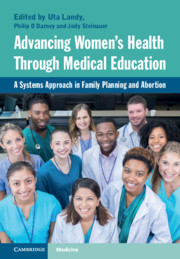 Advancing Women's Health Through Medical Education
Advancing Women's Health Through Medical Education from Section III - Family Planning Curricular Design & Implementation
Published online by Cambridge University Press: 30 July 2021
The chapter outlines the skills required to provide basic family planning care: contraceptive counseling; pregnancy options counseling; advocacy; screening for pregnancy intention, intimate partner violence and reproductive coercion; furthering of professional identity formation; and ethical reasoning. It describes justifications for their inclusion in medical school curricula. To increase the likelihood that the required knowledge and skills will not only be taught but also learned by all graduates, family planning educators need to join other educators in medical education reform, specifically the movement toward outcomes-based education, programmatic assessment and the fluent adoption of active-learning strategies. They should also continue to expand exposure to the more advanced skills required for abortion and contraception as to enhance student learning of basic skills, and positively impact attitudes toward patients and providers. Finally, it reviews meaningful opportunities for mentoring students and providing the role-modeling that nurtures respect for and interest in the field.
To save this book to your Kindle, first ensure [email protected] is added to your Approved Personal Document E-mail List under your Personal Document Settings on the Manage Your Content and Devices page of your Amazon account. Then enter the ‘name’ part of your Kindle email address below. Find out more about saving to your Kindle.
Note you can select to save to either the @free.kindle.com or @kindle.com variations. ‘@free.kindle.com’ emails are free but can only be saved to your device when it is connected to wi-fi. ‘@kindle.com’ emails can be delivered even when you are not connected to wi-fi, but note that service fees apply.
Find out more about the Kindle Personal Document Service.
To save content items to your account, please confirm that you agree to abide by our usage policies. If this is the first time you use this feature, you will be asked to authorise Cambridge Core to connect with your account. Find out more about saving content to Dropbox.
To save content items to your account, please confirm that you agree to abide by our usage policies. If this is the first time you use this feature, you will be asked to authorise Cambridge Core to connect with your account. Find out more about saving content to Google Drive.